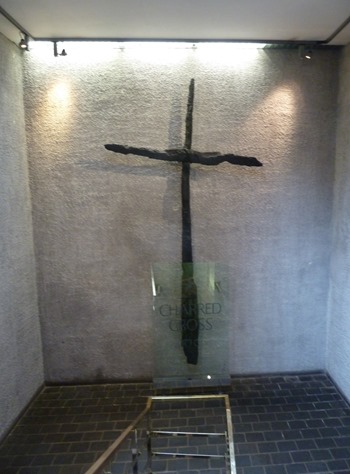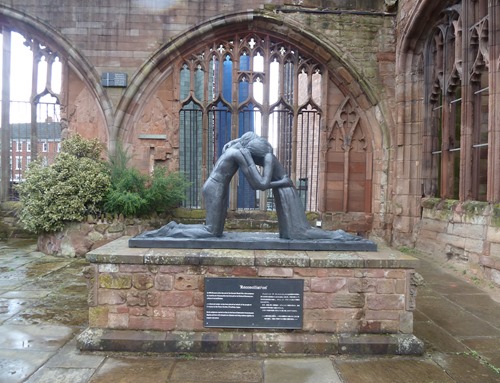
Last Monday I was in the West Midlands with work and took the opportunity to visit St Michael’s Cathedral in Coventry. It was a grey, rainy day, which probably didn’t show the building off to it’s best advantage. But the architecture, art and company lit up the day.
The Cathedral is a mix of old and new. The old Gothic style building was largely destroyed when it was bombed during the war. It was rebuilt in the1960’s in a modern style but incorporates parts of the ruined building as a memorial to the futility of war and as a symbol of reconciliation. The old and the new forming one church.

The new structure was designed by the architect Basil Spence in conjunction with the engineering firm Arup. A modernist design with form definitely following function, it reflected it’s time rather than looking backwards. It’s orientated north to south, rather than the usual east to west. The foundation stone on 23 March 1956 and the building was consecrated on 25 May 1962. It’s a simple design – essentially a functional brick box with little external ornamentation. Quite different to the Gothic ruins of the old cathedral.
On the southern end of the east wall, by the main entrance, there is an impressive sculpture by Jacob Epstein of St Michael’s Victory over the Devil
The entrance is round the corner from this sculpture, the “Screen of Saints and Angels” designed by John Hutton. This large glass structure is 70 feet high and 45 feet wide and is supported by a bronze framework hung by wires from the roof.
The screen is engraved with 66 larger-than-life figures and took ten years to create.
The ruins of the old cathedral can be seen through the glass.
The view down the nave and choir is dominated by the massive tapestry designed by Graham Sutherland

To give a sense of scale, the “little man” standing below the figure of Jesus, between his feet, is 4 1/2 feet tall but can hardly be seen in the above picture.
To the right when looking down the nave from the entrance is the Baptistry. The stained glass in the window was designed by John Piper.

Every individual pane is different
Looking from the south end of the building the Baptistry window is the only one that can be seen. The ten long narrow stained glass windows that punctuate the length of the cathedral are angled so that they can only be seen properly when observed from the north end of the cathedral, looking away from the altar. An unusual arrangement.


As is usual with Cathedrals, there are a number of chapels.
This is the Chapel of Christ in Gesthemane, in the north east corner. The mosaic, viewed here through the screen in the form of a crown of thorns, depicts the Archangel St Michael and was designed by Stephen Sykes.
Turning right, a passage leads to the Chapter House, or Chapel of Christ the Servant (also known as the Chapel of Industry). It’s like a giant glass cylinder and the dominant feature is the cross and crown of thorns, designed by Geoffrey Clarke, suspended above the altar.
Walking back past the altar we were able to get a closer look at the enormous tapestry.
We could also see the abstract sculpture of the “Cross of Nails” by Geoffrey Clarke on the altar
And these attractive large ceramic candlesticks by Hans Coper
To the west of the altar, at the top of the stairs leading down to the cloisters, hangs the “Charred Cross ” made from two charred oak beams that had fallen from the roof of the old cathedral after the blitz.
Descending the steps we were greeted by the beautiful “Chapel of the Stalingrad Madonna”.
It was built to house the image of the Virgin Mary drawn by Kurt Reuber, a German Soldier, during the Battle of Stalingrad in 1942.
The original is displayed in the Kaiser Wilhelm Memorial Church in Berlin (another church which is an amalgam of a gothic church ruined by bombing during the WWII with a modernist building) with another copy in Volgograd (formerly known as Stalingrad)
The chapel is enclosed by an etched glass screen and has a very modern airy feel. It was inaugurated to commemorate the Millennium, and is intended to provide a quiet space for prayer and contemplation.
At the South west end of the cathedral there is another chapel – “The Chapel of Unity”, which is used by all Christian denominations, not just the Church of England. I liked the mosaic floor which shows the five continents and symbols of the four gospels.

The ruins of the old Cathedral stand to the south of the new building. It was raining so being a couple of softies we didn’t spend too long looking around them. But there were some interesting features. Very typically Gothic in style, the tower escaped destruction in the blitz and visitors can pay an extra fee to climb to the top. But Coventry isn’t a particularly attractive city and I doubt that the effort and cost of the climb would be rewarded with a good view.

Standing against the south wall is another work by Jacob Epstein – Ecce Homo. Which is meant to depict Christ on trial before Pontius Pilate.
It wasn’t created specifically for the cathedral, dating from 1934/5 and only brought to Coventry in the 1970’s.
I liked this statue – Reconciliation – by Josefina de Vasconcellos – an English sculptor of Brazilian origin who lived in Cumbria much of her working life.
We spent a good couple of hours looking around the building. A really successful mix of old and new with some outstanding art and magnificent stained glass. I’m looking forward to reading about what Eirene made of our visit.


















